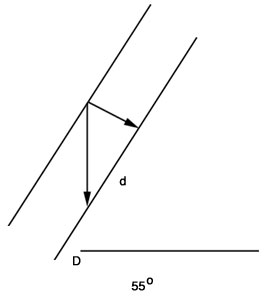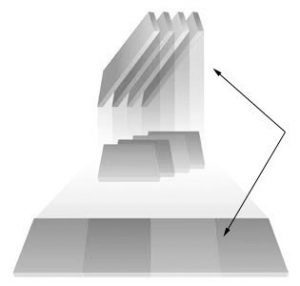Inclined Plate Clarifier Basic Theory of Operation
The Inclined Plate Clarifier, or Lamella, was first described and quantified by Hazen in 1904. The Lamella consists of a series of closely spaced flat plates inclined at an angle of from 45 to 60 degrees from horizontal. Preconditioned water with entrained solids enters the plate pack and flows between the plates. The path length, plate spacing, and angle of the plate are the usual engineering variables. As the water flows between pairs of plates, the heavy solids with a specific gravity higher than the surrounding water will settle onto the top surface of the lower plate, and slide down the inclined surface to be collected in the sludge hopper. Clear, near solids-free water then exits the top of the plate area and flows over an adjustable weir.
The settling pattern of a discrete particle in a rectangular basin is that, as the particle settles, it is carried forward by the velocity of the liquid flow through the basin. Thus, if Vf is the velocity of fluid, Vs the settling velocity of the particle, L the length of the basin, and d its depth, then a particle at the influent will settle to the bottom of the basin only if:
Vf max = Vs L/d
Therefore, the flow velocity at which a basin can operate successfully is directly proportional to the length of the basin, and inversely proportional to the depth.
This scenario applies to horizontal plates as well as rectangular basins. In horizontal plates, a particle must fall a few inches. In a rectangular basin, a particle must fall 10 to 20 feet. The more even the flow the more efficient the settling process.
Horizontal plate settlers are spaced 1 – 2 inches apart; therefore, the particle only needs to travel vertically 1 – 2 inches. The settled solids must be removed mechanically from the horizontal plates.
Inclined plate settlers are positioned on a 55-60 degree angle to allow the settled solids to slide down the plate and to the bottom of the basin. In this case the distance the particle must travel vertically is:
D= distance the particle travels vertically
d= plate spacing
Cos µ = Cosine of plate angle (550)
D = d , D = 2
Cosµ .574
D = 3.48″

Since the particle sees the horizontal area, horizontal plates are calculated as the actual settling area. Inclined plate settlers use the horizontally projected area and, therefore, the total plate area may be calculated by:
At = HP
Cosµ
HP = Horizontally projected area
Cos µ = Cosine of plate angle (550)
At = Total ft2 of plate surface required

Because each plate settler provides an effective settling area equal to that of its horizontal projection, MRI Plate Settlers will increase a basin’s effective settling area by up to ten times.

